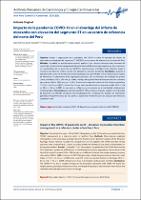Impacto de la pandemia COVID-19 en el abordaje del infarto de miocardio con elevación del segmento ST en un centro de referencia del norte del Perú
Related Resource(s)
https://apcyccv.org.pe/index.php/apccc/article/view/148Date
2021-09-25Author(s)
Carrión Arcela, Jean Pierre
Custodio Sánchez, Piero
Coca Caycho, Tatiana Gisell
Metadata
Show full item recordAlternate title
Impact of the Covid-19 pandemic on ST – elevation myocardial infarction management in a reference center of northern Peru
Abstract
Objetivo. Evaluar la repercusión de la pandemia del COVID-19 sobre el abordaje del infarto de miocardio con elevación del segmento ST (IMCEST) en un centro de referencia en el norte del Perú. Métodos. Se realizó un estudio observacional, analítico, tipo cohortes retrospectivas, derivado del registro de síndrome coronario agudo del Hospital Nacional Almanzor Aguinaga Asenjo. Se compararon las características de los pacientes con IMCEST y sus desenlaces a 30 días en dos cohortes según el momento de atención médica: previo a la pandemia o durante pandemia. Resultados. Durante la pandemia del COVID-19 disminuyeron las hospitalizaciones por IMCEST en 53%; hubo mayor empleo de fibrinólisis en detrimento de la angioplastia primaria, con incrementos en el tiempo de primer contacto médico (100 vs. 240 min, p= 0,006) y tiempo de isquemia hasta el intervencionismo coronario percutáneo (900 vs. 2880 min, p < 0,001). Se encontró mayor frecuencia de falla cardiaca posinfarto (21,1% vs. 46,7%, p= 0,002) y menor fracción de eyección del ventrículo izquierdo al alta (49,2 +/- 8,6 vs. 44,8 +/- 9,3, p= 0,009), sin que esto se refleje en un incremento de la mortalidad cardiovascular intrahospitalaria. Conclusiones. La pandemia COVID-19 ha tenido un impacto negativo en el abordaje de pacientes con IMCEST, disminuyó las hospitalizaciones y prolongó los tiempos de reperfusión generando mayor frecuencia de falla cardiaca posinfarto y menor fracción de eyección del ventrículo izquierdo al alta. Objective. To evaluate the impact of the COVID-19 pandemic on the ST–Elevation myocardial infarction (STEMI) management in a reference center of northern Peru. Methods. Observational, analytical, retrospective cohort-type study, derivated from the Acute Coronary Syndrome registry of the Almanzor Aguinaga Asenjo National Hospital. The characteristics of the patients with STEMI and their 30-day outcomes were compared in 02 cohorts according to the time of medical care: prior to the pandemic or during the pandemic. Results. During the COVID-19 pandemic, hospitalizations for STEMI decreased by 53%, there was a greater use of fibrinolysis to the detriment of primary angioplasty, with increases in the time of first medical contact (100 vs. 240 minutes, p = 0.006) and ischemic time to percutaneous coronary intervention (900 vs. 2880 minutes, p <0.001). This generated a higher frequency of post-infarction heart failure (21.1% vs. 46.7%, p = 0.002) and a lower left ventricular ejection fraction at discharge (49.2 +/- 8.6 vs 44.8 +/- 9.3, p = 0.009), without an increase in in-hospital cardiovascular mortality. Conclusions. The COVID-19 has had a negative impact on the treatment of patients with STEMI. We found less hospitalizations, prolonged reperfusion times, and higher frequency of post-infarction heart failure and lower left ventricular ejection fraction at discharge.






